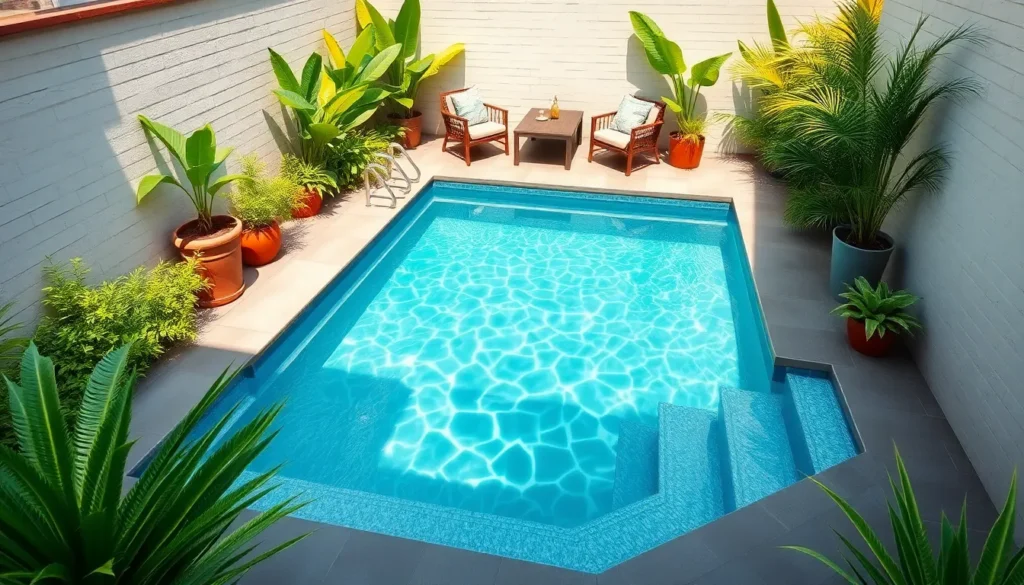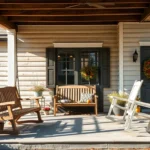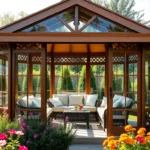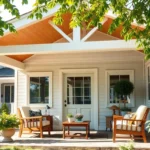We’ve all dreamed of having our own backyard oasis but thought limited space meant sacrificing that luxury. Small plunge pools are changing the game for homeowners who want to maximize their outdoor living without requiring acres of land. These compact water features pack all the relaxation and style of traditional pools into spaces you never imagined possible.
Whether you’re working with a tiny urban backyard or a cozy patio we’ll show you how creative design can transform even the smallest areas into stunning aquatic retreats. From sleek modern installations to natural rock formations these space-saving pool answers prove that size doesn’t determine impact.
Ready to jump into the possibilities? We’ve gathered the most innovative plunge pool ideas that’ll make your neighbors wonder how you fit so much luxury into such a small footprint.
Compact Corner Plunge Pools That Maximize Every Square Foot
Corner spaces often remain underutilized in small backyards, but they present perfect opportunities for compact plunge pool installations. We’ve discovered that strategic corner placement can transform awkward spaces into stunning aquatic focal points.
Triangular Corner Designs
Triangular plunge pools fit perfectly into corner spaces while creating unique geometric appeal. These custom shaped pools typically measure 8 to 12 feet along each side, providing enough space for relaxation without overwhelming compact yards. Corner triangle designs work exceptionally well in modern architectural settings where clean lines complement contemporary home styles.
Installation costs for triangular corner pools range from $15,000 to $35,000 depending on materials and features. We recommend fiberglass shells for easier installation in tight corner spaces, though concrete allows for complete customization of angles and depth. Most triangular designs include depths between 3.5 to 5 feet, perfect for cooling off and light exercise.
L-Shaped Space Utilizers
L-shaped plunge pools maximize corner real estate by wrapping around existing industry features like patios or garden beds. These designs typically span 10 to 15 feet in total length while maintaining compact widths of 6 to 8 feet. Corner L-shaped configurations create natural separation between different backyard zones without requiring additional fencing or barriers.
Smart L-shaped designs incorporate multiple depth levels to serve various purposes within the same footprint. We often see shallow lounging areas paired with deeper sections for cooling off during hot weather. These pools work particularly well in narrow corner spaces where traditional rectangular designs wouldn’t fit effectively.
Built-In Seating Integration
Corner plunge pools with integrated seating eliminate the need for separate patio furniture while maximizing water space. Built-in benches typically measure 18 inches wide and 18 inches deep, providing comfortable seating for 4 to 6 people in compact corner installations. These seating areas can include underwater lighting and massage jets for enhanced relaxation features.
Seamless seating integration creates smooth transitions between pool edges and surrounding hardscape materials. We recommend matching seating materials to existing patio surfaces for cohesive design flow. Corner seating arrangements also provide natural gathering spaces for entertaining while keeping the pool area compact and functional.
Elevated Deck Plunge Pools for Multi-Level Small Yards
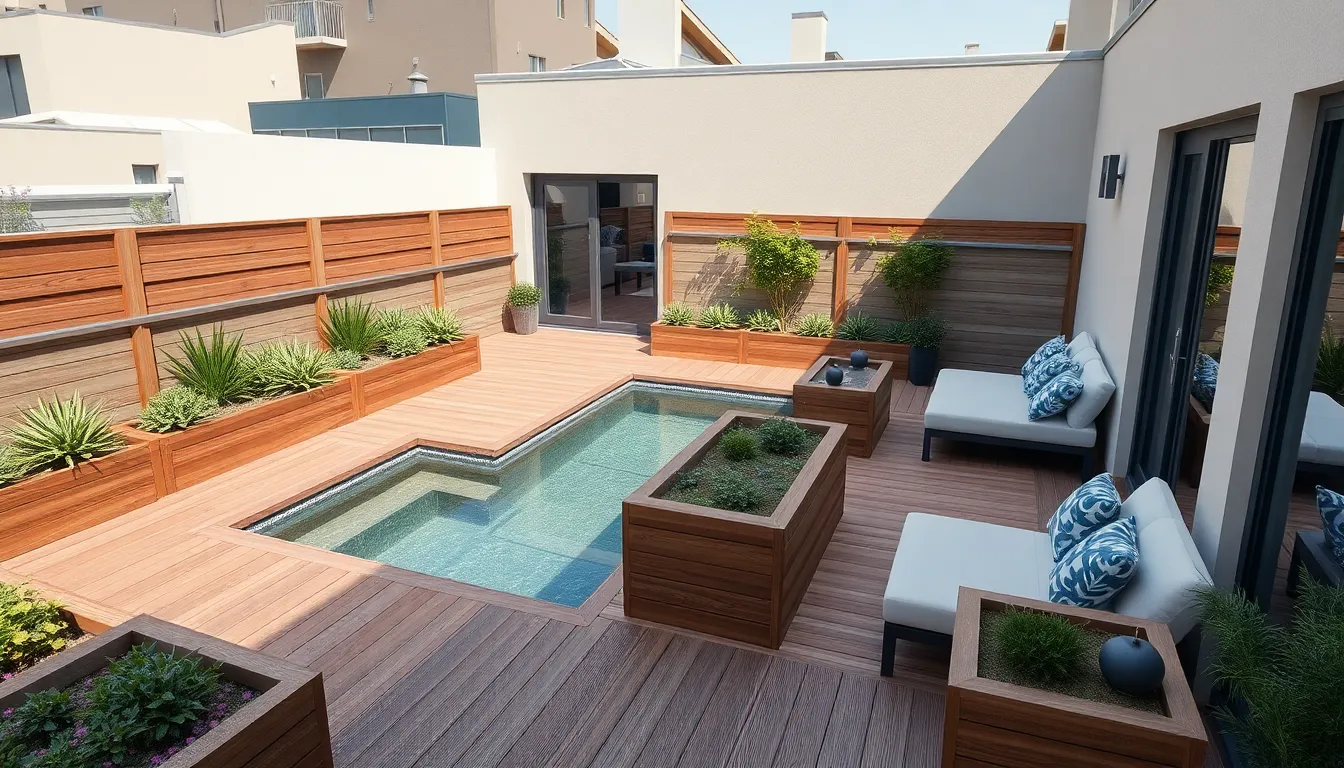
Vertical space becomes your best ally when working with sloped or tiered outdoor areas. Multi-level plunge pools on elevated decks create stunning architectural features while maximizing every square foot of your compact yard.
Raised Platform Installations
Above-ground and semi-above-ground plunge pools offer faster installation with less excavation than traditional inground options. Precast concrete plunge pools, cedar hot tubs, and galvanized stock tank pools work exceptionally well when elevated on wooden or composite decking platforms.
Installation costs typically range from $10,000 to $25,000 for raised platform systems, making them budget-friendly alternatives to full excavation projects. Plumbing and heating systems install more easily with raised platforms since we can access components without digging extensive trenches.
Natural seating areas emerge around the pool perimeter when we build platforms at varying heights. Multiple deck levels create lounging zones while the pool becomes the central focal point of your outdoor living space.
Deck Integration Techniques
Flush installation creates seamless transitions between pool and deck surfaces without visual interruptions. We recommend building plunge pools level with surrounding decking, then adding planter boxes, artificial turf, or paved dining areas to blend elements naturally.
Custom wood decking can enclose above-ground pools for a polished appearance without inground installation costs. This technique works particularly well with round or oval pool shapes that we can surround with curved deck sections.
Wood deck surrounds provide built-in seating around hot tubs and smaller plunge pools. Transition zones between water and dry relaxation areas become effortless when deck height matches pool coping.
Space-Saving Access Answers
Narrow steps built directly into deck structures provide safe entry without consuming valuable floor space. These integrated steps typically measure 12 to 18 inches wide and can double as seating when not in use.
| Access Solution | Space Required | Cost Range |
|---|---|---|
| Narrow Built-in Steps | 12-18 inches wide | $500-$1,200 |
| Ladder-style Entry | 2-3 feet depth | $200-$600 |
| Flush Edge Access | No additional space | $300-$800 |
Ladder-style entry points and foldaway steps minimize footprint requirements in tight spaces. Corner plunge pool designs optimize water volume while leaving maximum room for plantings and outdoor furniture arrangements.
Flush pool edges allow step-in access from any deck position, creating flexible seating opportunities around the entire perimeter. This design approach works especially well in narrow corridor layouts where traditional stairs won’t fit.
Indoor Plunge Pool Ideas for Year-Round Small Space Enjoyment
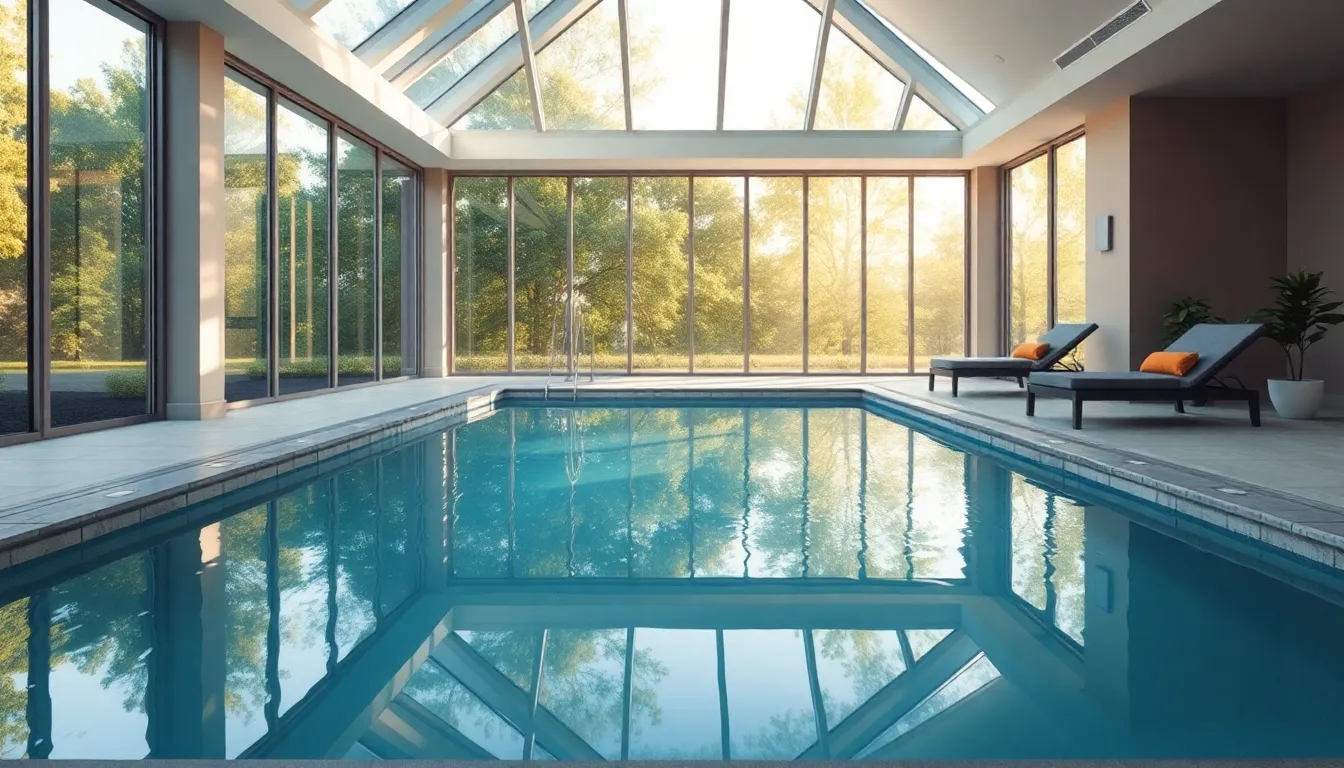
Moving beyond outdoor installations, we can create stunning indoor plunge pools that provide year-round aquatic enjoyment regardless of weather conditions. These compact pools typically measure 8 to 12 feet wide and 12 to 24 feet long, making them perfect for small indoor spaces.
Basement Installation Options
Converting unused basement space into a luxury wellness feature offers excellent potential for plunge pool installations. Basements provide the structural integrity needed to support pool installation when proper waterproofing and drainage systems are implemented.
Utilizing these underground areas maximizes your home’s square footage while creating a private retreat. We recommend focusing on ventilation and humidity control during the design phase to prevent moisture damage and maintain healthy air quality throughout your basement.
Installing durable moisture-resistant flooring around the pool perimeter ensures safety and longevity. Access considerations become crucial for basement installations, requiring safe stair or elevator entry points that accommodate wet conditions.
Designing for proper drainage prevents water accumulation that could damage your foundation. Professional waterproofing systems protect your investment and create a comfortable environment for year-round use.
Sunroom Integration Designs
Positioning plunge pools in sunrooms creates an indoor-outdoor experience that maximizes natural lighting and scenic views. Glass walls and skylights enhance the serene atmosphere while maintaining climate control benefits.
Blending indoor and outdoor elements through sunroom installations allows you to enjoy aquatic recreation regardless of seasonal weather changes. These spaces create relaxing retreats that feel connected to nature while providing indoor comfort.
Managing temperature fluctuations becomes essential in sunroom environments where glass surfaces can create greenhouse effects. We suggest incorporating shading answers or enhanced ventilation systems to prevent overheating during sunny periods.
Integrating with existing architecture allows sunroom plunge pools to complement your home’s design aesthetic. Modern rectangular spools, round options, or freeform designs can seamlessly fit different interior décor styles.
Climate Control Considerations
Controlling humidity levels represents the most critical aspect of indoor plunge pool maintenance. High-quality HVAC systems with dedicated dehumidifiers prevent mold growth and structural damage while maintaining comfortable air quality.
Regulating water temperature year-round requires efficient heating systems that keep pools at comfortable levels regardless of external climate conditions. These heating systems make plunge pools suitable for colder climates and basement locations.
Consuming less energy compared to full-sized pools, plunge pools provide cost-effective indoor aquatic recreation. Their compact size reduces heating and maintenance costs significantly.
Preventing moisture damage through proper ventilation systems protects your home’s structure and maintains comfortable humidity levels. We recommend professional climate control assessments to determine the right equipment for your exact installation.
Maintaining air circulation ensures fresh air exchange and prevents stagnant conditions that could lead to air quality issues. Strategic placement of ventilation systems creates optimal airflow patterns around your indoor plunge pool area.
Infinity Edge Plunge Pools That Create Visual Space Expansion
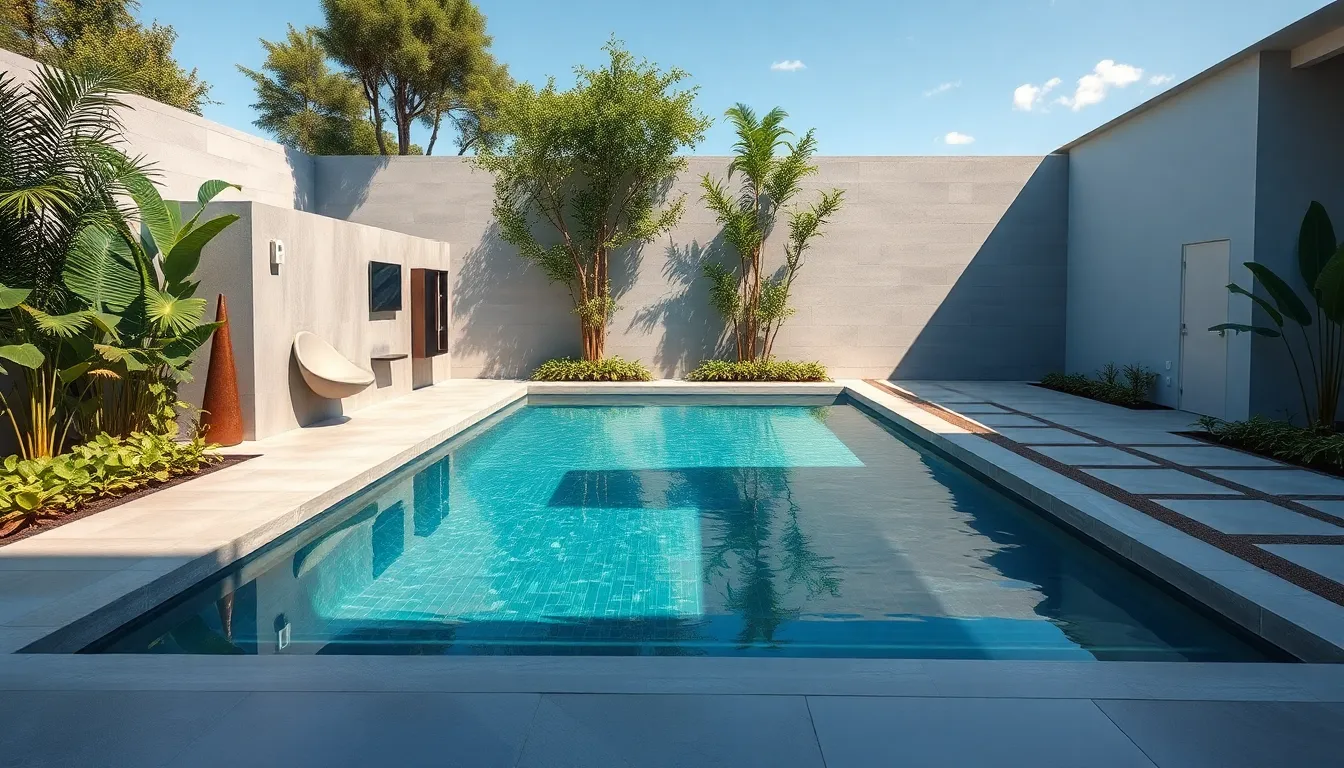
Infinity edge features transform small plunge pools into optical illusions that make compact spaces feel dramatically larger. We’ve found these designs particularly effective for maximizing the visual impact of limited square footage.
Wall-Mounted Infinity Designs
Wall-mounted infinity edges create the mesmerizing effect of water flowing endlessly beyond your pool’s boundaries. We recommend these installations for small yards because they integrate seamlessly with vertical elements like retaining walls or fence lines. Modern homeowners appreciate how the sleek water flow draws the eye upward and outward, making cramped spaces feel open and airy. Pool contractors often mount these systems 12 to 18 inches above ground level to maximize the visual drama while maintaining easy access for maintenance.
Ground-Level Infinity Effects
Ground-level infinity pools extend water surfaces flush with surrounding decks, patios, or landscaped areas for a mirror-like reflection effect. We’ve observed these designs create stunning visual continuity that tricks the eye into perceiving much larger spaces than actually exist. Water appears to blend seamlessly with hardscaping materials, eliminating harsh pool edges that can make small areas feel confined. Deck-level installations require precise grading and drainage planning, but the tranquil ambiance they create makes the investment worthwhile for space-conscious homeowners.
Mirror and Glass Enhancement Techniques
Reflective surfaces amplify infinity edge effects by doubling the visual impact of your plunge pool design. We install mirror-finish tiles along pool walls to create depth perception that extends far beyond actual dimensions. Glass panels and transparent barriers maintain safety requirements without blocking sight lines, preserving the open feel that small spaces desperately need. Contemporary installations often feature floor-to-ceiling glass walls that provide unobstructed views while maintaining the intimate scale perfect for compact plunge pools.
Multi-Functional Plunge Pools With Built-In Features
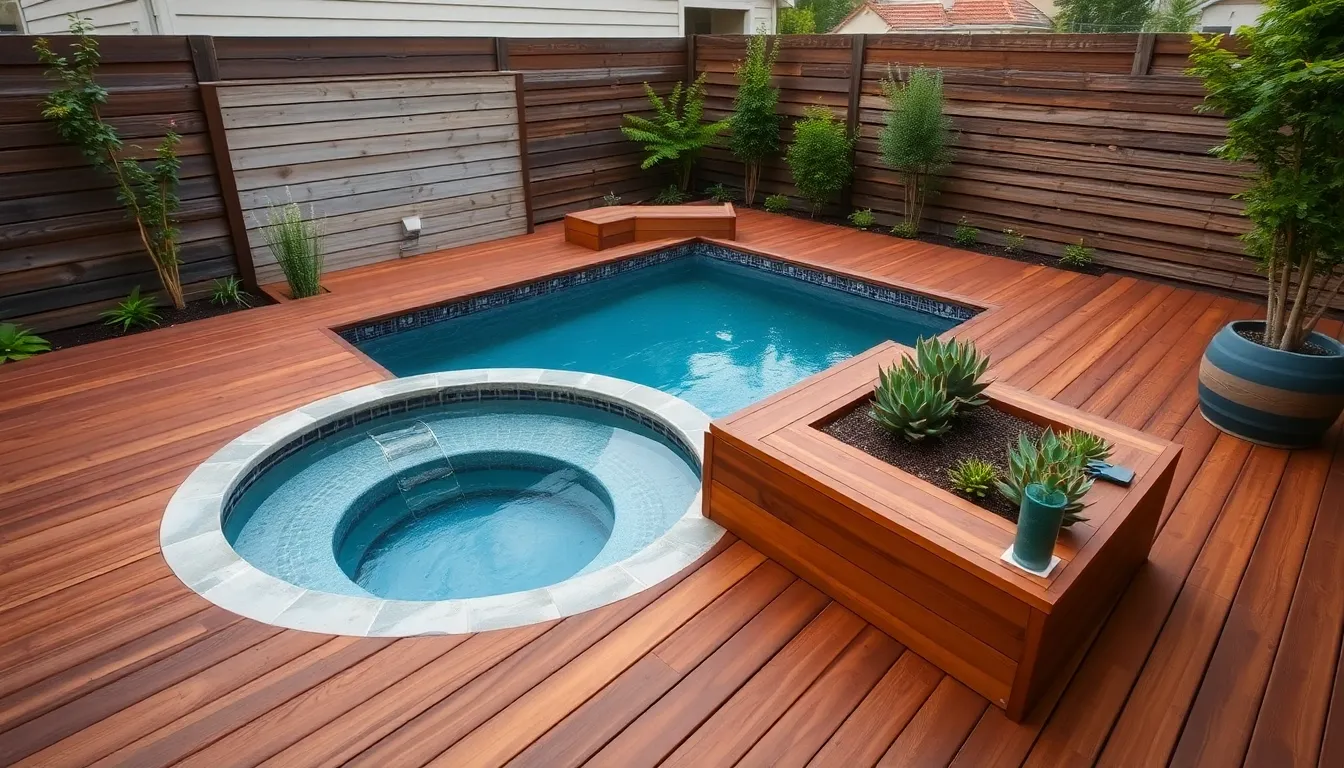
Smart design choices can transform basic plunge pools into versatile outdoor living spaces that serve multiple purposes. We’ll explore innovative features that maximize functionality while maintaining the intimate scale perfect for compact backyards.
Integrated Hot Tub Combinations
Above-ground plunge pools with heaters deliver year-round enjoyment by combining cooling and warming functions in one compact unit. Soake Pool designs exemplify this dual-purpose approach, offering both plunge pool refreshment during warm months and heated spa relaxation when temperatures drop.
Cedar hot tubs integrated alongside plunge pools create luxurious spa-like atmospheres that enhance the overall outdoor experience. Wooden decks surrounding these installations provide comfortable seating areas and foot soaking zones, extending the usable space beyond just the water features.
These combination systems typically feature heating elements and jacuzzi functions that can be controlled independently. We’ve found that homeowners appreciate the flexibility of switching between cooling off on hot summer days and warming up during cooler seasons without needing separate installations.
Built-In Planters and Landscaping
In-deck plunge pools with embedded planter boxes seamlessly integrate greenery directly into the pool area design. This approach creates natural transitions between hardscape and industry elements while softening the visual impact of pool edges in small spaces.
Easy-care potted plants and artificial turf surrounding plunge pools add natural beauty without demanding extensive maintenance. Modern minimalist designs particularly benefit from this low-upkeep landscaping approach, as it maintains clean lines while introducing organic textures.
Planter boxes built into pool decking serve dual purposes by housing both decorative plants and concealing necessary pool equipment. We recommend selecting drought-tolerant plants like succulents or ornamental grasses that thrive in poolside environments with minimal watering requirements.
Storage and Equipment Housing
Discrete equipment housing within decking structures or integrated planter designs keeps filtration and heating systems hidden from view. This concealment preserves the clean aesthetic essential for small-space pool installations where visible equipment can overwhelm the design.
Built-in storage compartments along pool edges provide convenient access to pool maintenance supplies and accessories. These spaces can be disguised as decorative elements or seamlessly integrated into seating areas, maximizing functionality without sacrificing visual appeal.
Custom equipment enclosures built into surrounding industry features maintain the cohesive look of multi-functional plunge pool designs. We’ve observed that proper ventilation within these housing answers prevents overheating while keeping mechanical components easily accessible for routine maintenance.
Portable and Above-Ground Plunge Pool Solutions
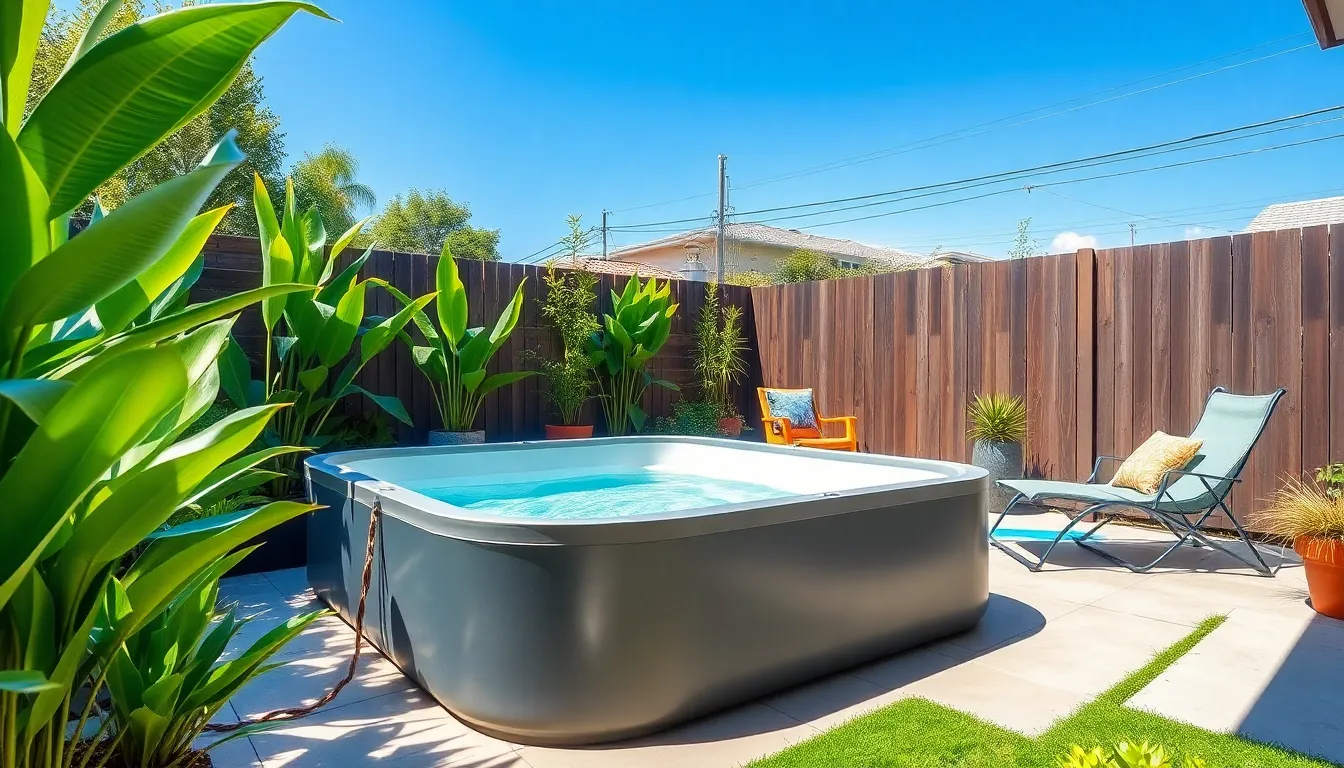
Portable plunge pools offer homeowners incredible flexibility to enjoy aquatic recreation without permanent installation commitments. These answers work perfectly when you’re renting, have challenging terrain, or want to test pool ownership before investing in permanent structures.
Prefabricated Small Pool Options
Companies like The Little Pool Co. revolutionize small space swimming with pre-made instant fiberglass pools that eliminate lengthy construction timelines. Their pools arrive in various shapes, colors, and finishes, requiring only a level concrete pad and electrical connection for immediate enjoyment.
Above-ground fiberglass plunge pools with full composite exoskeletons provide exceptional durability while maintaining installation simplicity. These pools work brilliantly on rooftops, tight spaces, or areas where excavation isn’t feasible, offering professional-grade quality without traditional construction headaches.
Portable lap pools from companies like EZ Pools deliver US-made prefabricated packages that assemble quickly and cost considerably less than traditional in-ground installations. Their design accommodates challenging sites where conventional pools simply won’t work, opening possibilities for previously impossible locations.
Pre-cast concrete plunge pools, such as Plungie models, combine concrete’s durability with rapid installation speeds that are 74% faster than traditional pool construction. This premium prefabricated option delivers long-term value while respecting time constraints and small space requirements.
Temporary Installation Ideas
Pop-up pools transform any level surface into an instant aquatic retreat, perfect for seasonal enjoyment or testing different pool locations. These designs set up quickly in spring and pack away completely at season’s end, requiring only proper draining, cleaning, and storage to prevent winter damage.
Blow-up pools offer ultimate convenience for renters or those uncertain about long-term pool commitments. Their lightweight construction allows easy relocation, while standard pool chemicals like chlorine maintain water quality throughout the swimming season.
Partial burial combined with creative decking integrates portable pools into irregular sites without permanent ground disturbance. This approach allows you to achieve custom appearances while maintaining the flexibility to relocate or remove the pool entirely.
Budget-Friendly Alternatives
Inflatable and metal frame portable pools represent the most affordable entry point into plunge pool ownership, requiring minimal upfront investment while delivering genuine swimming experiences. These options use standard pool maintenance supplies and provide years of enjoyment when properly cared for.
Metal-frame and ultra-frame pools balance affordability with enhanced durability, featuring sturdy construction that withstands regular use while remaining cost-effective. Their modular design allows easy assembly without specialized tools or professional installation services.
Prefabricated pools eliminate expensive excavation and construction labor costs that typically drive up traditional pool projects. By streamlining the installation process, these answers significantly reduce total investment while still providing quality swimming experiences that rival permanent installations.
Narrow Lap-Style Plunge Pools for Rectangular Spaces
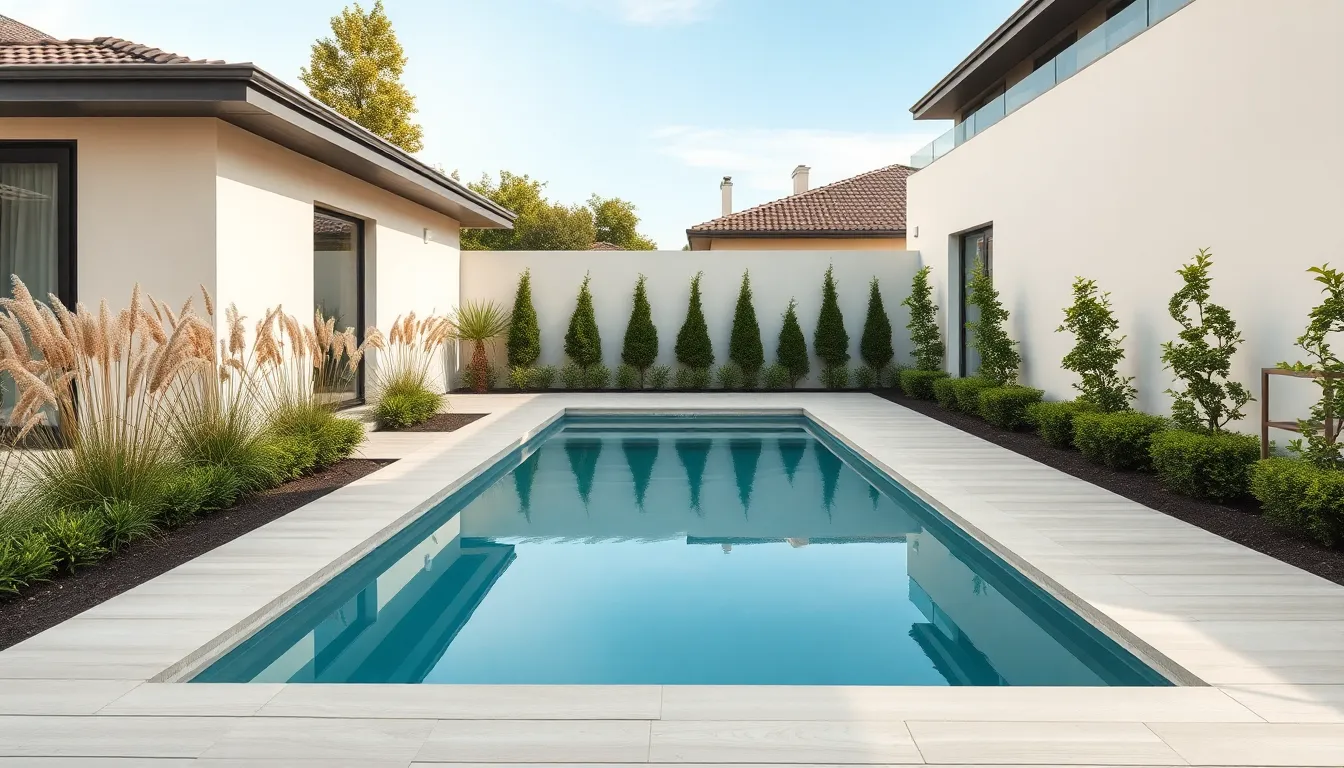
Rectangular yards and corridor-like spaces benefit tremendously from narrow lap-style plunge pools that maximize every square foot. These elongated designs transform challenging narrow spaces into functional swimming areas perfect for exercise and relaxation.
Linear Design Maximization
Elongated shapes work exceptionally well in rectangular plots where traditional wide pools simply won’t fit. We’ve found that stretching the pool lengthwise while minimizing width creates the most efficient use of available space.
Length optimization allows for short laps even in compact footprints, typically ranging from 12 to 20 feet long and 6 to 8 feet wide. This configuration provides genuine swimming opportunities without overwhelming the yard.
Streamlined aesthetics complement modern and minimalist outdoor settings beautifully. The clean lines create visual flow that makes the entire backyard feel more spacious and uncluttered.
Strategic placement along property lines or against walls maximizes usable yard space for other activities. We recommend positioning these pools to take advantage of natural shade patterns and privacy screening.
Swim Current Integration
Swim current systems transform narrow plunge pools into endless swimming experiences through powerful jet technology. These swim-in-place features eliminate the need for extensive pool length while providing excellent exercise opportunities.
Jet placement typically involves installing 2-3 adjustable swim jets at one end of the pool to create consistent water flow. The current strength can be adjusted from gentle resistance to challenging workout intensity.
Energy efficiency of modern swim jet systems makes them practical additions to small pools. Most units consume similar energy to a large hot tub while delivering professional-grade swimming resistance.
Exercise versatility expands beyond swimming to include water aerobics, resistance training, and rehabilitation exercises. The controlled current provides stability for various fitness routines in minimal space.
Streamlined Decking Answers
Parallel decking runs alongside narrow plunge pools to enhance their linear appearance and create seamless outdoor living areas. Wood or composite materials work best for maintaining clean lines and visual continuity.
Integrated storage can be built into decking structures to house pool equipment, cleaning supplies, and outdoor furniture. We’ve seen clever answers that incorporate hidden compartments within bench seating.
Seating arrangements follow the pool’s linear design with built-in benches or moveable furniture that doesn’t interrupt sight lines. Corner seating areas can be created at pool ends without compromising the streamlined aesthetic.
Landscaping alignment uses plantings and hardscaping elements that complement the pool’s geometry. Ornamental grasses, boxwood hedges, and linear planters enhance the sophisticated appearance while requiring minimal maintenance.
Rooftop Plunge Pool Ideas for Urban Small Spaces
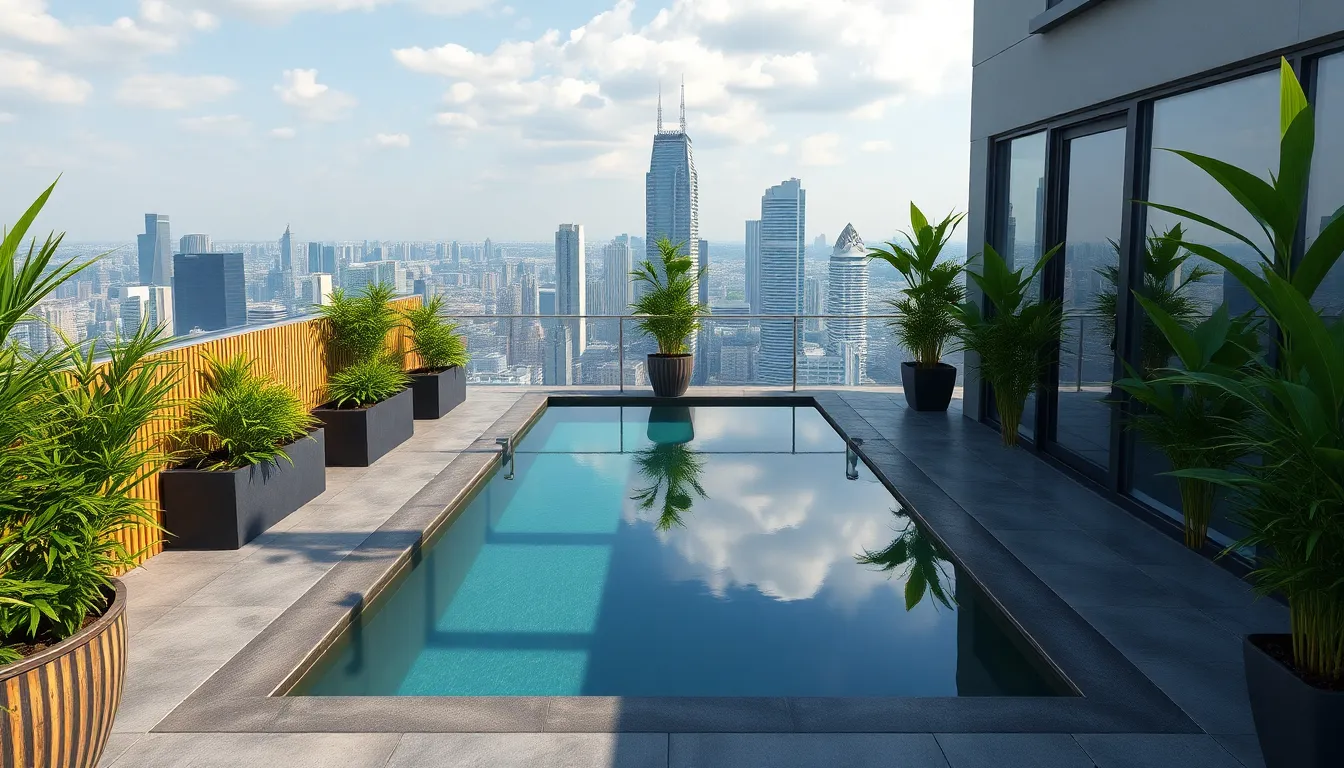
Urban rooftops offer unique opportunities for creating stunning plunge pool retreats high above the city streets. We’ll explore the essential considerations for transforming these elevated spaces into luxurious aquatic escapes.
Weight and Structural Considerations
Structural load capacity represents the most critical factor when planning rooftop plunge pools in urban environments. Plunge pools filled with water create important weight that requires proper structural support to prevent building damage or safety hazards.
Engineering consultation becomes essential before any rooftop pool installation begins. We recommend hiring structural engineers to assess your rooftop’s load bearing capacity and determine if reinforcement is necessary for safe pool installation.
Lightweight materials offer practical answers for reducing overall pool weight on rooftop installations. Fiberglass and composite pool shells provide durability while minimizing structural load compared to traditional concrete construction methods.
Waterproofing systems protect the building structure from water damage through proper drainage and sealing techniques. Professional waterproofing prevents leaks that could compromise the building’s integrity and create costly repair situations.
Privacy Screen Integration
Privacy challenges arise naturally in densely populated urban areas where neighboring buildings create visibility concerns. Rooftop plunge pools require strategic screening answers to create secluded retreat spaces away from prying eyes.
Bamboo fencing provides natural privacy barriers that complement water features while blocking views from adjacent buildings. These sustainable materials create warm, tropical atmospheres that enhance the overall pool experience.
Tall planters filled with lush greenery serve dual purposes by providing privacy and improving air quality around the pool area. Strategic placement of these planted screens creates natural barriers without sacrificing aesthetic appeal.
Vertical gardens offer modern privacy answers that transform blank walls into living artworks while screening pool areas. These green walls contribute to peaceful atmospheres and provide effective visual barriers from neighboring properties.
Wind Protection Strategies
Wind exposure creates important challenges for rooftop pool environments, causing uncomfortable conditions and increased water evaporation rates. Urban rooftops often experience stronger wind currents than ground level locations require specialized protection strategies.
Glass panel barriers shield pool areas from wind while maintaining open sight lines and natural light access. These transparent windbreaks provide effective protection without creating enclosed, claustrophobic feelings around the water.
Windbreak walls offer solid protection from prevailing winds through strategic placement around pool perimeters. Design these barriers to complement the overall aesthetic while providing necessary wind reduction for comfortable pool use.
Planted wind screens using tall shrubs create natural barriers that filter wind currents without completely blocking airflow. Strategic landscaping with wind resistant plants provides protection while maintaining the rooftop’s open atmosphere throughout the year.
Budget-Friendly DIY Plunge Pool Projects for Small Areas
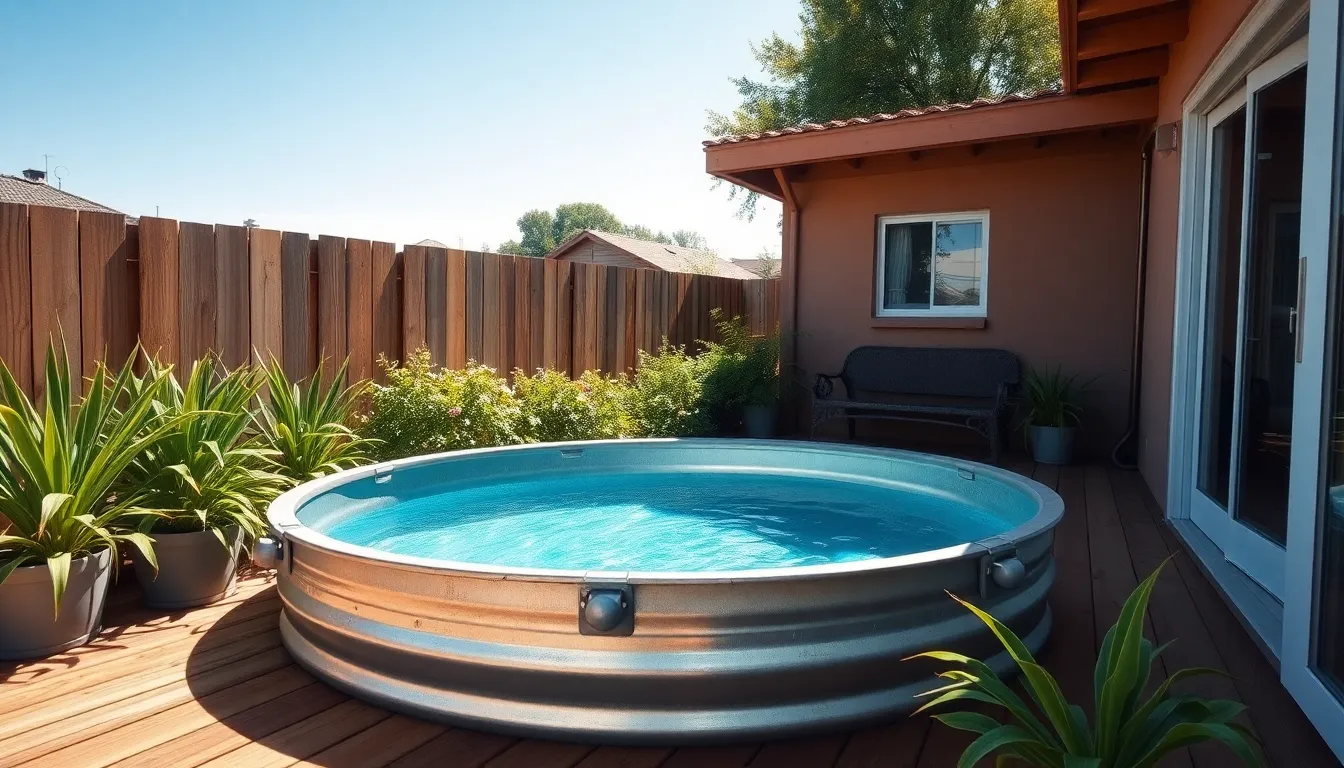
Creating your own plunge pool doesn’t have to expensive when you choose the right approach. We’ll explore three cost-effective methods that transform small spaces into refreshing aquatic retreats.
Stock Tank Pool Conversions
Stock tank pools offer the most affordable entry point into plunge pool ownership for compact spaces. Agricultural tanks made from galvanized steel or heavy-duty plastic provide durable, ready-made vessels that require minimal modification.
Converting these tanks involves adding filtration systems, heating elements, and surrounding decking to create a functional plunge pool. Metal tanks typically cost between $200 and $800 depending on size, while complete conversion kits add another $500 to $1,500 to your total investment.
Installation requires basic plumbing skills and can be completed in a weekend with proper preparation. We recommend choosing 8-foot diameter tanks for optimal swimming space while fitting into most small yard configurations.
Customization options include wooden decking platforms, built-in seating, and decorative surrounds that integrate seamlessly with existing landscaping. These conversions work exceptionally well for rental properties since they can be relocated if needed.
Concrete Block Construction
Concrete block construction provides maximum customization while maintaining budget-friendly costs for small plunge pools. This method allows complete control over pool shape, depth, and size to fit any compact space configuration.
Building with concrete blocks involves stacking hollow blocks in your desired pattern, then reinforcing the structure with rebar placed inside the cores. We fill these cores completely with concrete to create waterproof, structurally sound walls that can withstand ground pressure and water weight.
Foundation preparation requires pouring a concrete slab base with proper drainage and screeded levels to prevent settling issues. Curved junctions between walls and floor eliminate stress concentration points that could lead to cracking over time.
Proper concrete curing takes 28 days to reach full strength, so we recommend planning your construction timeline accordingly. Wall reinforcement using steel rods every 16 to 24 inches ensures long-term structural integrity.
Finishing options include plastering, tile work, or specialized pool paints that provide both waterproofing and aesthetic appeal. Material costs typically range from $2,000 to $5,000 for a basic 8×12 foot plunge pool, not including labor if you hire professionals for specialized work.
Liner Installation Techniques
Pool liners deliver quick, professional-looking results with minimal construction expertise required for small plunge pool projects. Vinyl liners can be custom cut to accommodate irregular shapes or space constraints that standard pool shells cannot address.
Preparation involves creating a smooth, stable base using either poured concrete or properly compacted sand depending on your soil conditions. We ensure the substrate is completely level and free from sharp objects that could puncture the liner material.
Installation requires careful measurement and precise cutting to achieve wrinkle-free results that look professionally installed. Vinyl liners anchor securely using coping stones or perimeter track systems that hide raw edges while providing structural support.
These systems work particularly well with concrete block construction since the smooth liner surface eliminates the need for expensive plastering or tile work. Replacement costs remain reasonable compared to permanent finishes, making maintenance more manageable over time.
Quality liners typically last 10 to 15 years with proper care, providing excellent value for budget-conscious homeowners. We recommend 20-mil thickness for durability in high-use applications, while 28-mil options offer premium longevity for long-term installations.
Conclusion
Small spaces shouldn’t limit your dreams of having a personal aquatic retreat. We’ve shown you that with the right design approach creative answers and smart planning you can transform even the tiniest outdoor or indoor area into a stunning plunge pool oasis.
Whether you choose a corner installation elevated deck design indoor basement conversion or budget-friendly DIY project there’s a plunge pool solution that fits your space constraints and financial goals. The key lies in maximizing functionality while maintaining the luxury and relaxation you’re seeking.
Your compact plunge pool awaits – it’s time to jump into creating the perfect small-space sanctuary that’ll provide years of enjoyment and add important value to your property. The possibilities are endless when you think creatively about your available space.
Frequently Asked Questions
What is a plunge pool and how does it differ from a regular pool?
A plunge pool is a compact, shallow pool designed for relaxation and cooling off rather than swimming laps. Unlike traditional pools, plunge pools typically measure 8-15 feet in length and are designed to maximize luxury in minimal footprints, making them perfect for small backyards, patios, or urban spaces where full-sized pools aren’t feasible.
How much does it cost to install a small plunge pool?
The cost varies by design and installation type. Triangular corner plunge pools range from $15,000 to $35,000, while above-ground and semi-above-ground options cost $10,000 to $25,000. Portable and prefabricated options offer the most budget-friendly alternatives, with DIY stock tank conversions being the most affordable entry point.
What are the best plunge pool designs for small spaces?
Corner installations, including triangular and L-shaped designs, maximize underutilized spaces. Elevated deck pools work well for sloped areas, while narrow lap-style pools suit rectangular yards. Infinity edge designs create visual space expansion, and portable options offer flexibility for renters or challenging terrain situations.
Can plunge pools be installed indoors?
Yes, indoor plunge pools offer year-round enjoyment regardless of weather. Popular locations include basements and sunrooms. However, proper waterproofing, drainage, ventilation, and climate control systems are essential. Indoor installations require efficient HVAC systems and dehumidifiers to maintain air quality and prevent moisture damage.
Are there DIY options for building a plunge pool?
Yes, several budget-friendly DIY methods exist. Stock tank pool conversions are the most affordable, requiring filtration systems and decking additions. Concrete block construction offers customization potential, while vinyl liner installations provide professional finishes. These options significantly reduce costs compared to professionally installed pools.
What features can be added to maximize plunge pool functionality?
Multi-functional features include integrated hot tub combinations, built-in seating, planters for landscaping, and storage solutions within decking structures. Swim current systems can transform narrow pools into endless swimming experiences. These additions enhance versatility and extend the pool’s use as an outdoor living space.
Can plunge pools be installed on rooftops?
Rooftop installations are possible but require careful planning. Critical considerations include structural load capacity assessments, lightweight materials like fiberglass, proper waterproofing systems, and engineering consultations. Privacy solutions like bamboo fencing and wind protection strategies such as glass barriers are also necessary for urban rooftop environments.
What maintenance is required for small plunge pools?
Plunge pools require less maintenance than full-sized pools due to their smaller water volume. Regular tasks include water testing, cleaning, and equipment maintenance. Indoor pools need additional attention to humidity control and ventilation systems. Built-in storage solutions help keep maintenance supplies organized and easily accessible.

